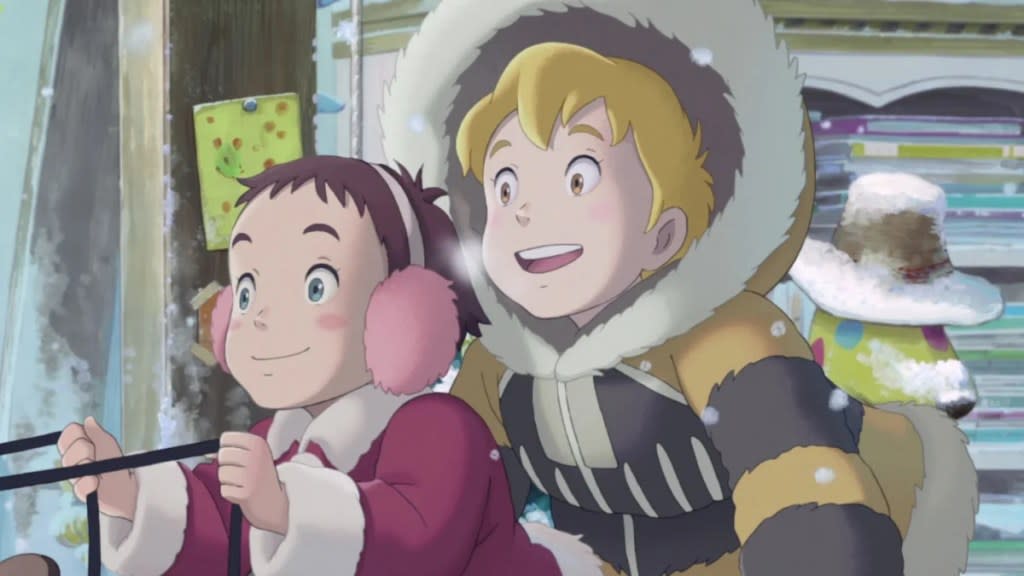‘The Imaginary’ Review: Studio Ponoc’s Horror-Tinged Animated Film Is a Visual Feast

Back in 2014, the future of Studio Ghibli was uncertain. Hayao Miyazaki had announced his latest retirement (which he’s broken twice since), and the acclaimed studio shut down all production for an indefinite break. This led a group of staffers, including producer Yoshiaki Nishimura, to leave and found Studio Ponoc. Their debut film, “Mary and the Witch’s Flower” felt like a continuation of the Ghibli style — visually and thematically. Now, many years later, the studio is finally back with a new film in “The Imaginary.” Adapted from the illustrated book by A.F. Harrold and Emily Gravett, this is a beautifully animated tale of imaginary friends, grief, and of running for your lives because you’re being chased by anime Pennywise and his J-horror ghost girl companion.
Director Yoshiyuki Momose, who worked as a key animator on classics like “Porco Rosso” and “Spirited Away,” directs the film from a script by Nishimura. The story follows Amanda, a lonely girl living with her mother Lizzie in a struggling bookstore. Amanda spends most of her time playing in wildly creative imaginary worlds with her best friend, Rudger who lives in the attic. Lizzie can’t see or hear Rudger, because he happens to be an imaginary friend, but to Amanda, he is more real than anything else in the world. So real that she is willing to sacrifice herself for Rudger when they start being chased by Mr. Bunting, an eerie Hawaiian shirt-wearing old man who not only sees Rudger, but literally wants to consume him. A confrontation forces Rudger and Amanda to become separated, sending Rudger on a wild adventure as he meets other Imaginaries and goes on vastly different adventures in other kids’ dreams, all to reunite with Amanda and save the day before Mr. Bunting kills them all.
“The Imaginary” could be just a cute story about the power of friendship and imagination, but it is Mr. Bunting who steals the show and makes the film a great time — this is the most horrifying animated villain in more than a decade. Mr. Bunting is a character with a unique design that initially looks like just another creepy old guy until he gets close and his gullet expands impossibly wide to try and suck Imaginaries like a vacuum. This is an all-ages version of Pennywise the Clown; not a person but a primordial being who is part legend, part immortal monster, his gullet illuminated by the light of countless Imaginaries still visible and in agony like they’re in anime hell.
If the sight of Mr. Bunting wasn’t enough, he is not alone. It turns out he used to have an imaginary friend, but he refused to stop believing as he got older, so he started eating other Imaginaries to preserve the magic, even as his friend turned ghastly, with a dead expression, black holes for eyes and long black hair — in essence, Sadako Yamamura for the entire family!
But that’s not the only horror in “The Imaginary,” a film that echoes a time when movies meant for all ages dared include real darkness, characters scary enough to live in children’s nightmares for years, emotional moments that felt real because they were earned through peril. Indeed,” The Imaginary” is big on horror the way something like “Spirited Away” was, without fully traumatizing young audiences. Here, when kids grow up, the Imaginaries don’t go to a foster home to play and have fun, they literally turn to dust and die — and when their kids die, the Imaginaries feel a big emptiness that never leaves them. How can a being born out of imagination survive with no one to dream them up?
In the great tradition of Ghibli movies, there’s an emotionally heavy throughline about grief in the story. Every Imaginary friend is born out of a specific necessity, and in the case of Amanda it’s her grief over her father’s death. We see how differently she experiences her grief compared to her mother, as “The Imaginary” explores the power of imagination in the face of trauma — resulting in some very poignant moments.
Studio Ponoc does a fantastic job with the visuals of “The Imaginary,” with beautiful backgrounds of an English town and a visual palette that looks like moving illustrations of a children’s book. But where the film shines is when the Imaginaries start going into different worlds imagined by kids, like a space sci-fi sequence with ships and plenty of effects, or simply a quiet scene in a Venice-like square. The character design also shows bountiful creativity, as we see all kinds of creatures in different shapes and sizes — including imaginary friends from people like Beethoven, Shakespeare and Picasso.
Since Ghibli returned last year with “The Boy and the Heron,” Studio Ponoc’s “The Imaginary” feels less like a game changer or like it’s filling a hole in the industry. Nevertheless, this is a poignant, visually pleasant film that animation fans can appreciate, with a healthy dose of age-appropriate terror to ensure kids won’t forget it for a long time.
“The Imaginary” will be released on Netflix on July 5.
The post ‘The Imaginary’ Review: Studio Ponoc’s Horror-Tinged Animated Film Is a Visual Feast appeared first on TheWrap.

 Yahoo News
Yahoo News 
